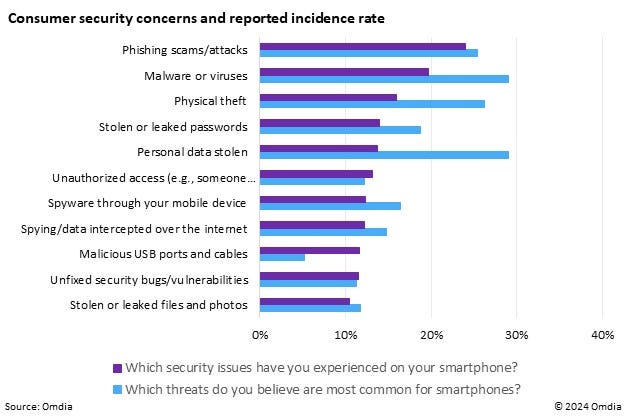
Enterprise cybersecurity technology research that connects the dots.
Phishing Attacks Are the Most Common Smartphone Security Issue for ConsumersPhishing Attacks Are the Most Common Smartphone Security Issue for Consumers
New hands-on testing results show that most devices are unable to catch phishing emails, texts, or calls, leaving users at risk.
_Thomas_Bethge_Alamy.jpg?width=1280&auto=webp&quality=95&format=jpg&disable=upscale)
Highlights:
Consumer survey shows that the most common security issues are phishing attacks, such as text or emails seeking personal information, as well as malware and physical theft.
Hands-on device testing shows that Samsung S24 offers the best anti-phishing protection, while the Google Pixel 9 Pro leads in many other areas.
The iPhone 16 Pro and other premium Android smartphones from Honor, Xiaomi, and OnePlus lack security features and protections.
COMMENTARY
New research from Omdia shows that the security capabilities on several of the latest consumer smartphones, including top devices from Apple, Google, and Samsung, fail to detect several types of common phishing attacks.
As part of the fourth-annual Omdia Mobile Device Security Scorecard, Omdia surveyed 1,572 consumers across 13 major countries in the Americas, Asia and Oceania, and Europe, in October 2024. This survey covered the demographics of smartphone users, their security concerns and attitudes, their perception of the most common security threats, and the key smartphone purchasing drivers.
Consumers reported that the most common security issue they encountered was phishing scams and attacks (texts, emails or calls which use false pretenses to try to get the target to give away valuable personal information), with 24% reporting to have experienced phishing.
Omdia also asked consumers to rate how important various security features were, with anti-phishing having the largest net-importance rating. In fact, over the four years Omdia has conducted its Mobile Device Security Scorecard research, anti-phishing has been rising in importance. This is no surprise, as phishing not only becomes more common, but also as consumers become more familiar with the attacks and the potential for personal information theft or financial loss.
The next most common security issue was malware and viruses. The third most common was physical theft, such as pickpocketing, mugging or snatching.
Mobile Device Security Testing Results
For each of these security issues, Omdia tested leading premium smartphones to determine availability and effectiveness of security features and capabilities. Google's Pixel 9 Pro and Samsung's Galaxy S24 both scored highly, ahead of Apple's iPhone 16 Pro and other leading Android-based devices, including the OnePlus 12, Xiaomi 14, and Honor Magic 6 Pro.
Despite the importance consumers place on phishing prevention on mobile devices, the anti-phishing features failed to some degree on every device Omdia tested. No device caught all the attempted phishing texts, calls, and emails initiated as part of the testing.
Several of the devices did catch simulated spam calls: All Android devices from Google, Xiaomi, OnePlus, Honor, and Samsung, which have voice call protection, flagged suspected spam calls before the recipient could answer the call. The iPhone 16 Pro, however, did not have the same protections and did not catch the simulated spam call.
Text messages with malicious short links were sent from an unknown number and sender ID, but these were not successfully caught by the test devices. Simulated phishing emails were sent from both Gmail and Google's Mail Delivery subsystem, but no device caught the phishing emails from Gmail; the messages were only identified as spam when sent from Google's SMTP.
Despite not all phishing texts and emails being caught, once malicious links were opened on the devices, those that use Google Safe Browsing protections successfully blocked the link from opening. A warning screen was raised, forcing the user to bypass it to proceed.
Yet not all Android devices performed similarly: Samsung Internet blocked most links except the more sophisticated custom URLs, while the Xiaomi Mii and OnePlus Internet browsers failed to warn the user even when loading known malicious links.
In previous years' testing, smartphones have been able to detect and successfully block or warn against the attempted phish. However, the difference year-on-year showcases the ever-changing nature of threats.
Lack of Mobile Security Impacts Consumer Trust
The lack of effective security protections on mobile devices, particularly against the growing threat of phishing attacks, is eroding consumer trust.
When Omdia asked consumers if their trust following a security issue increased (due to how well the issue was handled) or decreased, 73% reported they had reduced trust in the smartphone brand and operating system developer.

Despite some manufacturers' efforts to ensure the latest mobile device security protections are in place, Omdia notes that it is difficult to protect against 100% of phishing attempts. This highlights the severity of the issue and potential impact to consumers.
That said, Omdia asserts that smartphone manufacturers can (demonstrated by the more advanced phishing protection capabilities on the market) and should have more effective baseline phishing protection in place — such as voice call protection, and all Android devices making use of Google’s Safe Browsing protections.
Omdia sees the value in the phishing protection features implemented by the leading smartphone vendors, and how this can help to protect consumers — at least in most instances, based on Omdia's latest round of testing.
However, these features need to be paired with awareness activity from manufacturers, as well as the wider industry, to help consumers be vigilant and prepared for the instance when a security threat evades a protection mechanism. Such awareness adds an important additional layer of protection against the rising number of scams targeting consumers through their mobile devices.
Read more about:
OmdiaAbout the Authors
You May Also Like



